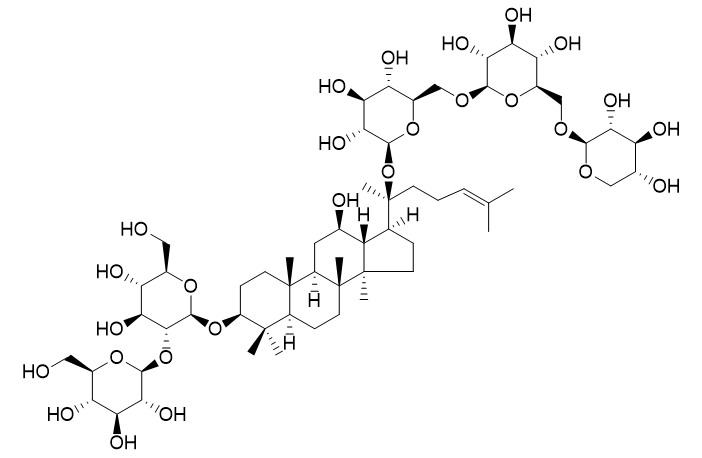Notoginsenoside R4
Reference standards.
Inquire / Order:
manager@chemfaces.com
Technical Inquiries:
service@chemfaces.com
Tel:
+86-27-84237783
Fax:
+86-27-84254680
Address:
1 Building, No. 83, CheCheng Rd., Wuhan Economic and Technological Development Zone, Wuhan, Hubei 430056, PRC
Providing storage is as stated on the product vial and the vial is kept tightly sealed, the product can be stored for up to
24 months(2-8C).
Wherever possible, you should prepare and use solutions on the same day. However, if you need to make up stock solutions in advance, we recommend that you store the solution as aliquots in tightly sealed vials at -20C. Generally, these will be useable for up to two weeks. Before use, and prior to opening the vial we recommend that you allow your product to equilibrate to room temperature for at least 1 hour.
Need more advice on solubility, usage and handling? Please email to: service@chemfaces.com
The packaging of the product may have turned upside down during transportation, resulting in the natural compounds adhering to the neck or cap of the vial. take the vial out of its packaging and gently shake to let the compounds fall to the bottom of the vial. for liquid products, centrifuge at 200-500 RPM to gather the liquid at the bottom of the vial. try to avoid loss or contamination during handling.
The Journal of Internal Korean Medicine2015, 36(4):486-497
Applied Biological Chemistry2023, 66:8
Plant Archives2020, 2(1),2929-2934
Plant Cell Physiol.2018, 59(1):128-141
TCI CO.2019, US20190151257A1
Journal of Ginseng Research2019, 10.1016
Int J Mol Sci.2019, 20(14):E3538
Asian J of Pharmaceutical&Clinical 2018, 11(2)
Industrial Crops and Products2019, 140:111612
Biomed Pharmacother.2020, 128:110318.
Related and Featured Products
Planta Med. 2001 Jul;67(5):417-22.
Effects of ginsenosides from Panax ginseng on cell-to-cell communication function mediated by gap junctions.[Pubmed:
11488454 ]
Gap junctions have been shown or are believed to be involved in the pathogenesis of many inherited and acquired human diseases. Agents that regulate the gap junction-mediated intercellular communication (GJIC) function may facilitate prevention and treatment of GJIC-involved diseases.
METHODS AND RESULTS:
In the present study we examined the effects of 27 ginsenosides isolated from Panax ginseng on GJIC. The results show that compounds 1 (oleanolic acid), 2 (ginsenoside-R0), 3 (ginsenoside-Rb1), 5 (ginsenoside-Rb2), 7 (ginsenoside-Rd), 8 (ginsenoside-Rg3), 12 (panaxadial), 13 (Notoginsenoside R4), 17 [ginsenoside-Rg2 (20S)], 18 (ginsenoside-Rf), and 26 (ginsenoside-F3) did not obviously affect GJIC, whereas compounds 4 (ginsenoside-Rc), 6 (ginsenoside-Rb3), 9 (ginsenoside-Rd2), 10 (notoginsenoside-Fe), 11 (ginsenoside-Rh2),14 (ginsenoside-Ra1), 15 (ginsenoside-Re), 16 [ginsenoside-Rg2 (20R)], 19 (ginsenoside-Ia), 20 [ginsenoside-Rh1 (20S)], 21 [ginsenoside-Rh1 (20R)], 22 (ginsenoside-F1), 23 (protopanaxatriol), 24 (panaxatriol), 25 (ginsenoside-Rg1), and 27 (chikusetsaponin-L8) induced GJIC reductions at various degrees. Compounds 2, 7, and 8 protected against the tyrosine phosphatase inhibitor vanadate-induced GJIC reduction, while compounds 1, 5, 7, and 17 inhibited the cytokine interleukin 1 alpha (IL-1alpha)-induced reduction in GJIC. Nevertheless, no compounds protected against the protein kinase C (PKC) activator 12-O-tetradecanoylphorbol-13-acetate (TPA)-induced GJIC inhibition. On the other hand, GJIC reductions induced by compounds 6, 9,10, 20, 21, 22, 24, and 25 were inhibited by the tyrosine kinase (TK) inhibitor genistein, while GJIC reductions induced by compounds 6, 9, 14, 16, 19, 21, and 24 were attenuated in the presence of the PKC inhibitor calphostin C. However, GJIC reductions induced by compounds 4, 23, and 27 were not inhibited either by genistein or by calphostin C.
CONCLUSIONS:
These data indicate that various mechanisms are responsible for effects of ginsenosides on GJIC.
Zhongguo Zhong Yao Za Zhi. 2013 Sep;38(17):2807-17.
Chemical constituents from roots and rhizomes of Panax ginseng cultivated in Jilin province.[Pubmed:
24380303]
METHODS AND RESULTS:
The chemical constituents of the roots and rhizomes of Panax ginseng were systematically investigated by various column chromatographic methods including Amberlite XAD-4 macroporous adsorptive resins and silica gel as well as high-performance liquid chromatography, and their chemical structures were identified by physico-chemical properties and spectral analyses. Twenty-eight compounds were isolated from the 70% ethanolic-aqueous extract and identified as koryoginsenoside R1 (1), ginsenoside Rg1 (2), ginsenoside Rf (3), notoginsenoside R2 (4), ginsenoside Rg2 (5), notoginsenoside Fe (6), ginsenjilinol (7), ginsenoside Re5 (8), noto-ginsenoside N (9), notoginsenoside R1 (10), ginsenoside Re2 (11), ginsenoside Re1 (12), ginsenoside Re (13), ginsenoside Rs2 (14), ginsenoside Ro methyl ester (15), ginsenoside Rd (16), ginsenoside Re3 (17), ginsenoside Re4 (18), 20-gluco-ginsenoside Rf (19), ginsenoside Ro (20), ginsenoside Rc (21), quinquenoside-R1 (22), ginsenoside Ra2 (23), ginsenoside Rb1 (24), ginsenoside Ra1 (25), ginsenoside Ra3 (26), ginsenoside Rb2 (27), and Notoginsenoside R4 (28).
CONCLUSIONS:
All isolated compounds are 20 (S) -protopanaxadiol or protopanaxatriol type triterpenoid saponins. Compound 1 was isolated from the roots and rhizomes of P. ginseng cultivated in Jilin province for the first time and compound 6 was isolated from the roots and rhizomes of P. ginseng for the first time. The 1H-NMR data of compounds 6, 14 and 19 were assigned for the first time.



